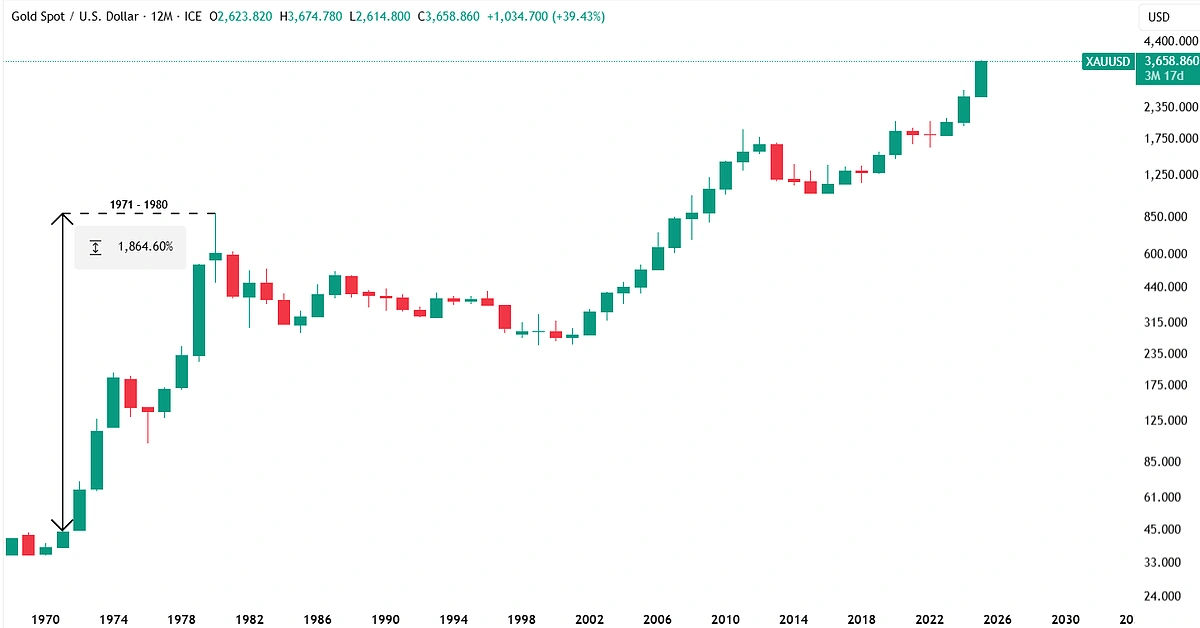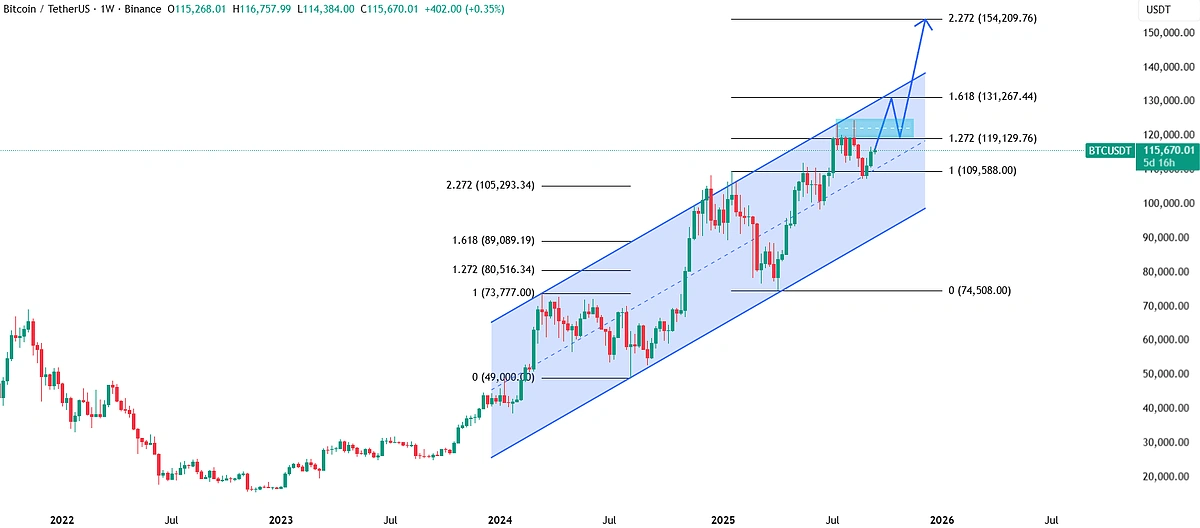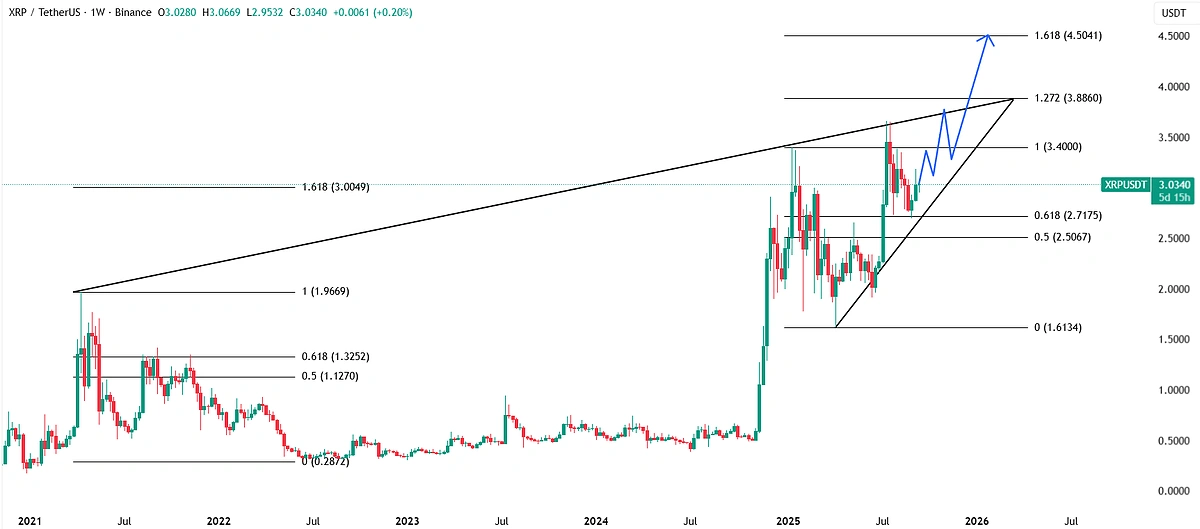This article is brought to you and written by FBS.

The latest U.S. data are flashing early stagflation signals. Headline CPI rose 0.4% month-on-month—hotter than the 0.3% expected and the previous 0.2%—pushing annual inflation to 2.9%. Inflation is not cooling; it is re-accelerating.
At the same time, the Bureau of Labor Statistics quietly revised non-farm payrolls down by 911,000 jobs for the past year. That’s nearly a million fewer jobs than initially reported—a brutal reminder that the labor market is weaker than headlines suggested.
Taken together, these may be the first clear signs that stagflation is returning.
Déjà Vu from the 1970s
The setup feels familiar. In the 1970s, the U.S. economy was hit by the same toxic mix now re-emerging: rising prices and slowing growth. Inflation surged into double digits, unemployment climbed above 7%, and real GDP stagnated. For investors, it was a nightmare decade where both stocks and bonds failed to protect wealth.
The trigger back then was monetary and political missteps. After President Nixon removed the US dollar from the gold standard in 1971, the dollar was unanchored from gold just as oil shocks and loose fiscal policy drove inflation higher. The Federal Reserve tried to fight unemployment with easier money, only to make inflation worse.

Gold became the only reliable hedge. After an initial run from $35 to nearly $180 by 1974, the metal suffered a brutal correction — dropping almost 50% by 1976. Many declared the “gold trade” dead. But that correction was only the prelude: from 1976 to 1980, gold skyrocketed from around $100 to $800+, an eightfold surge that turned it into the ultimate stagflation asset.
The parallels today are hard to ignore: US inflation is proving sticky, the labor market is wobbling, and amidst all this the Fed seems to be on the verge of easing monetary policy to stimulate jobs, but risk further inflation. The open question is whether gold will once again be the default safe haven—or whether Bitcoin is now ready to take that crown.
Gold’s Historic Role as a Stagflation Hedge
In the stagflation era of the 1970s, gold proved itself as the ultimate hedge. When stocks and bonds delivered negative real returns, gold preserved—and multiplied—wealth. From 1971 to 1980, its price surged nearly eightfold, fueled by the collapse of Bretton Woods, oil shocks, and runaway inflation.

Chart: For the first time since 1996, foreign central banks now hold more gold than U.S. Treasuries as a share of their reserves.
But this raises a different question: if gold was the hedge for an industrial economy, isn’t Bitcoin the natural alternative for a financial system built on the internet? With its fixed supply and native digital infrastructure, Bitcoin speaks the language of a younger generation that grew up online. In a world facing stagflation 2.0, it may not be central banks but digital natives who decide which asset becomes the ultimate store of value.
Bitcoin as Digital Gold
Let’s skip the basics. Everyone here knows Bitcoin’s supply cap and its “digital gold” label. The real question is performance—and history shows Bitcoin reacts to monetary easing far more explosively than gold.
During the COVID crisis in 2020, when the Fed unleashed trillions in QE, gold rose about 20%. Respectable—but Bitcoin surged almost sixfold in less than a year. The difference wasn’t just narrative—it was scale. Gold’s market cap is over $24 trillion, while Bitcoin’s sits near $2.3 trillion. Moving a trillion dollars into gold barely nudges the price. The same flow into Bitcoin transforms the market. That’s why in environments of fiat debasement, Bitcoin doesn’t just hedge—it amplifies.
What makes this cycle different is institutional adoption. With the launch of Bitcoin ETFs from BlackRock, Fidelity, and others, BTC has shifted from a fringe asset to a portfolio hedge available at the click of a button. Pension funds, asset managers, and family offices now have access to Bitcoin through the same rails they use for gold and equities.
That changes the calculus. Gold may still protect wealth, but Bitcoin has the potential to multiply it. If stagflation does return, investors now have a choice between gold and Bitcoin.
Beyond Bitcoin—ETFs and Altcoins
For years, institutions only had one way into crypto: Bitcoin. That’s no longer the case. With ETFs now covering Ethereum, Solana, XRP, and even Dogecoin, traditional investors can access a broader range of digital assets. Crypto is evolving from a single-asset trade into a full asset class.
The dynamic is similar to the 1970s. Gold was the ultimate store of value, but silver—with both monetary and industrial demand—surged even more dramatically. Today, Bitcoin plays the role of gold: the pure hedge, the reserve asset. But altcoins resemble silver: they not only store value, they power real economic activity through smart contracts, payments, and tokenization.
That’s why flows rarely stay in one place. Bitcoin may capture the first wave, but liquidity historically rotates into assets with broader utility. ETFs accelerate this process by legitimizing the entire segment, giving capital an easy path from BTC into ETH, XRP, or SOL. In a stagflationary cycle, that rotation could be the spark for the next major altseason.
BTC Outlook

Bitcoin is trading within a clear ascending channel, holding above $115,000. After bouncing from the midline of the channel, price action is now pressing toward the upper boundary. A confirmed breakout and weekly close above resistance near $120,000 – 125,000 would open the path toward the Fibonacci extension targets at around $131,000 (1.618) and ultimately towards $154,000 (2.272).
As long as BTC holds above the $109,500 support zone, the bullish structure remains intact. In a stagflationary environment, such technical setups highlight how Bitcoin could lead the next leg higher as capital flows into ETF-backed assets.
XRP Outlook

XRP is consolidating inside a rising wedge pattern around the $3.00 mark. The structure is defined by higher lows and converging resistance, a setup that often leads to sharp moves once a breakout occurs.
Key levels to watch are $3.40—a breakout above here would open the way toward Fibonacci extensions at $3.88 (1.272) and $4.50 (1.618). On the downside, critical supports lie at $2.70 (0.618) and $2.50 (0.5).
With XRP ETFs already listed in Canada, institutional exposure could reinforce bullish momentum if flows rotate into altcoins. A confirmed breakout above resistance would mark the next leg higher, potentially positioning XRP as one of the leaders in a stagflation-driven altseason.
Conclusion: The Hedge of a Digital Age
The 1970s taught investors one hard truth: when growth stalls and inflation rises, traditional financial assets fail and investors go in search of “hard” assets. Gold saved portfolios then, but its dominance reflected the structure of that era’s economy—industrial, physical, dollar-centric.
Today the backdrop looks eerily familiar, but the financial system is not the same. Gold is still relevant, and central banks continue to buy it, but it already trades at record levels. Bitcoin and, increasingly, altcoins now provide a parallel hedgereddeswss—one built for a networked, digital economy.
Institutional ETFs are accelerating this shift, giving capital a regulated gateway into Bitcoin, and perhaps further on to the wider crypto market. If stagflation 2.0 takes hold, the hedge of the 21st century may not be found in vaults, but on-chain.
In that sense, investors are facing the same choice as in the 1970—only updated for the internet era: gold for safety, crypto for scale?
Disclaimer: The opinions expressed in this article are the author’s own and do not necessarily reflect the views of CoinGecko. This content is for informational purposes only and should not be construed as financial, investment, or any other form of advice. CoinGecko does not guarantee the accuracy or completeness of the information presented and is not liable for any decisions made based on this content.
